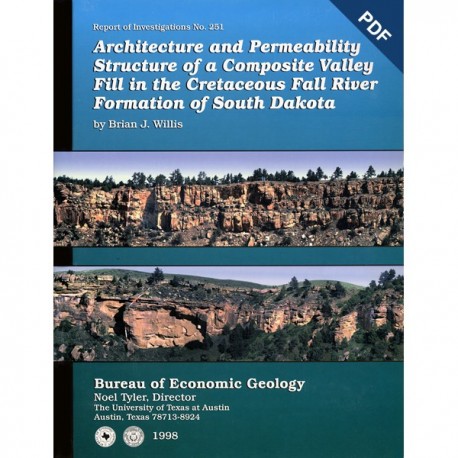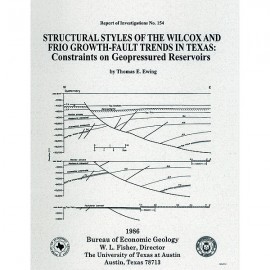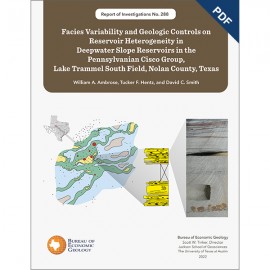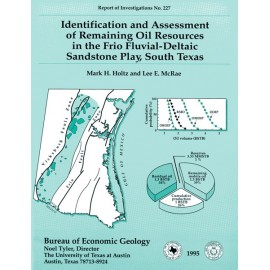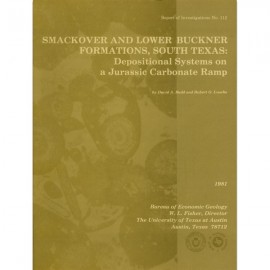Reports of Investigations
-
Books & Reports
- Reports of Investigations
- Guidebooks
- Udden Series
- Geological Circulars
- Down To Earth
- Atlases of Major Oil and Gas Reservoirs
- Texas Memorial Museum Publications
- Environmental Geologic Atlas of the Texas Coastal Zone
- Mineral Resource Circulars
- Other Reports
- Seminars and Workshops
- Handbooks
- Submerged Lands of Texas
- Symposia
- Annual Reports
- Open File Reports
-
Maps & Cross Sections
- Thematic Maps
- Miscellaneous Maps, Charts & Sections
- Geologic Atlas of Texas
- STATEMAP Project Maps
- Geologic Quadrangle Maps
- Cross Sections
- Highway Geology Map
- Energy and Mineral Resource Maps
- Shoreline Change and Other Posters
- Wilcox Group, East Texas, Geological / Hydrological Folios
- Bouguer Gravity Atlas of Texas
- River Basin Regional Studies
- Featured Maps
- Posters
- Teachers & the Public
-
Geological Society Publications
- Gulf Coast Association of Geological Societies
- Alabama Geological Society
- Austin Geological Society
- Corpus Christi Geological Society
- Houston Geological Society
- Lafayette Geological Society
- Mississippi Geological Society
- New Orleans Geological Society
- South Texas Geological Society
- GCS SEPM Publications
- Historic BEG & UT Series
Architecture and Permeability Structure of ... Fall River Formation, South Dakota. Digital Download
RI0251D
For a print version: RI0251.
RI0251D. Architecture and Permeability Structure of a Composite Valley Fill in the Cretaceous Fall River Formation of South Dakota, by B. J. Willis. 61 p., 41 figs., 2 tables, 2 oversize plates, 1998. doi.org/10.23867/RI0251D. Downloadable PDF.
To purchase this publication in book format, please order RI0251.
About This Publication
The author of this research mapped strata, facies, and permeability trends through a compasite valley-fill standstone in the Fall River Formation, exposed in Red Canyon, South Dakota. Findings demonstrate the complexity of depositions formed in low-accommodation basin settings.
ABSTRACT
The Fall River Formation is a 45-m-thick layer of fluvial-dominated valley fills and shore-zone strata deposited on the stable cratonic margin of the Cretaceous Western Interior Seaway. Fall River deposits in Red Canyon, located in the southwest corner of South Dakota, expose a cross section of a 3.5-km-wide valley-fill sandstone and laterally adjacent marine deposits. Mapping of changes in stratal architecture, facies, and permeability along this cross section records rock heterogeneities that can influence subsurface fluid flow and reservoir production behavior.
The 3.5-km-wide, 30-m-thick compound valley-fill sandstone cuts into a succession of meters-thick, upward-coarsening, marine shore-zone strata and muddy alluvial-plain deposits. Each valley-fill basal erosion surface records an episode of valley incision and relative sea-level fall; the gradual progression from fluvial to more estuarine deposits upward within each fill records relative sea-level rise. All fills, dominantly channel deposits, are either capped by marine-flooding surfaces or truncated by overlying valley fills. The dominance of channel deposits, the gradual change to more estuarine facies in the upper parts of fills, and the location of flooding surfaces at valley-fill tops all suggest that sediment supply initially kept pace with relative sea-level rise and that valleys filled during late marine lowstand and transgression, not during subsequent highstands.
Permeability is controlled by facies architecture and stratigraphy. Distinct permeability contrasts occur between (1) the marine deposits and the composite valley-fill sandstone, (2) individual valley fills that compose the composite sandstone, (3) different types of smaller scale sediment bodies within each valley fill, and (4) different lithofacies within individual sediment bodies. These contrasts generally decrease across progressively smaller scales of strata. The largest scale variations might be correlated in subsurface reservoirs, whereas smaller scale variations need to be modeled statistically.
Recently proposed facies models have focused on variations in the relative strength of tide, wave, and river currents as controls on valley-fill deposits. Relative rates of sediment supply and basin accommodation change, however, and the shift in this ratio along the depositional profile during multiple-scale cycles of relative sea-level rise and fall are equally important controls on the style of valley-fill deposits. This study demonstrates the importance of defining rock-property trends in a sedimentologic framework when characterizing complex valley-fill reservoir sandstones.
Keywords: Cretaceous, Fall River Formation, fluvial, permeability, sedimentology, valley fill
CONTENTS
ABSTRACT
INTRODUCTION
METHODS
SEDIMENTOLOGIC AND PERMEABILITY
Mudstone-Dominated Deposits
Sequence 1
Description
Interpretation
Sequence 2
Description
Interpretation
Sequence 3
Description
Interpretation
Permeability
Major Sandstone
Valley Fill 1
Description
Interpretation
Valley Fill 2
Description
Interpretation
Valley Fill 3
Description
Interpretation
Valley Fill 4
Description
Interpretation
Permeability
Trends across valley fills
Sediment bodies within valley fills
Lithofacies
REGIONAL PATTERNS OF DEPOSITION IN VALLEY FILLS
Stratigraphic Model
Fall River Deposition
CONCLUSTIONS
ACKNOWLEDGMENTS
REFERENCES
Figures
1. Stratigraphic columns and map showing age of Lower Cretaceous formations flanking the Powder River Basin, Wyoming and South Dakota
2. Map of Red Canyon in the Black Hills of South Dakota
3. South-north cross sections of bedding and generalized facies exposed in Red Canyon
4. Selected south-north-aligned sedimentologic logs measured in Red Canyon
5. Generalized lithofacies types observed in Fall River deposits of Red Canyon
6. Photographs of marine strata exposed in Red Canyon
7. Paleocurrent orientations measured from dip direction of cross-strata in Red Canyon deposits
8. Vertical section and permeability log through marine strata
9. Photographs of valley-fill sandstones exposed in Red Canyon
10. Bedding diagrams showing stratal surfaces in composite valley-fill sandstone 6
11. Permeability trends of valley-fill sandstones in Red Canyon
12. Permeability variations near the axis of the composite valley-fill sandstone and traces of valley-fill basal erosion surfaces
13. Permeability variations near the margin of the composite valley-fill sandstone and traces of valley-fill basal erosion surfaces and flooding surfaces
14. Distribution of permeability values in valley fills 1 through 4, in axial and marginal areas
15. Distribution of grain size in valley fills 1 through 4, in axial and marginal areas
16. Proportion of lithofacies types in valley fills 1 through 4, in axial and marginal areas
17. Contour map and south-north cross section B-B' of a reservoir sandstone body in the Mannville Group
18. Idealized changes in sediment bodies upward within valley fills exposed in Red Canyon
19. Horizontal permeability logs through different types of sediment bodies exposed in Red Canyon
20. Plot of grain size versus permeability of Fall River valley-fill sandstones exposed in Red Canyon
21. Distribution of deposit permeability and grain size in different lithofacies types
22. Horizontal permeability logs across the top and base of two cross sets
23. Process-based classification
24. Distribution of energy types, morphological components in plan view, and sedimentary facies in cross section within an idealized wave-dominated estuary
25. Stages in the filling of a wave-dominated estuary
26. Distribution of depositional energy types, morphological components in plan view, and sedimentary facies in cross section within an idealized tide-dominated estuary
27. Two models of valley-fill evolution
28. Two depositional models of valley-fill deposits shown as longitudinal cross sections
29. Simplified Wheeler diagrams of schematic deposits shown in figure 28
30. Schematic showing temporal changes in the rate of sea-level variations controlling the rate of shoreline transgressions and regressions independently of basin slope
31. Formation of sharp-based shoreface and detached lowstand shoreface parasequences
32. Schematic cross section and plan view of valley trend, showing that small-scale cycles in relative sea level can modulate the filling of valleys during regional transgression
33. Map showing isolated reservoirs aligned in a string along the Fall River valley trend, which passes through Red Canyon
34. Depositional response to relative sea-level fall
35. Formation of valleys through migration of knickpoints
36. Schematic showing where shapes and fills of valleys change systematically as slope changes across the basin
37. Progressive increase in valley accommodation with sea-level rise
38. Cretaceous Interior Seaway during maximum flooding during the Early Cretaceous
39. Five stratigraphic units on three cross sections within the Fall River Formation of the southern Powder River Basin
40. Northwest-southeast cross section A-A' of the Fall River and adjacent formations spanning 800 km from northernmost Wyoming to northern Montana
41. Northwest-southeast cross sections A-A' and B-B', showing Aptian- to Albian-age Mannville Group in western Canada, approximately coeval and down the axis of the seaway from the Fall River Formation
Tables
1. Statistical tests to determine whether valleys have distinct permeability distributions
2. Statistical tests to determine whether lithofacies types have distinct permeability and grain-size distributions
Plates (in book pocket)
1. Photo, bedding diagram, and associated sedimentologic and permeability logs from near the axis of the valley-fill sandstone body exposed in Red Canyon, South Dakota
2. Photo, bedding diagram, and associated sedimentologic and permeability logs from near the margin of the valley-fill sandstone body exposed in Red Canyon, South Dakota
Citation
Willis, B. J., 1998, Architecture and Permeability Structure of a Composite Valley Fill in the Cretaceous Fall River Formation of South Dakota: The University of Texas at Austin, Bureau of Economic Geology Report of Investigations No. 251D, 61 p. doi.org/10.23867/RI0251D.
